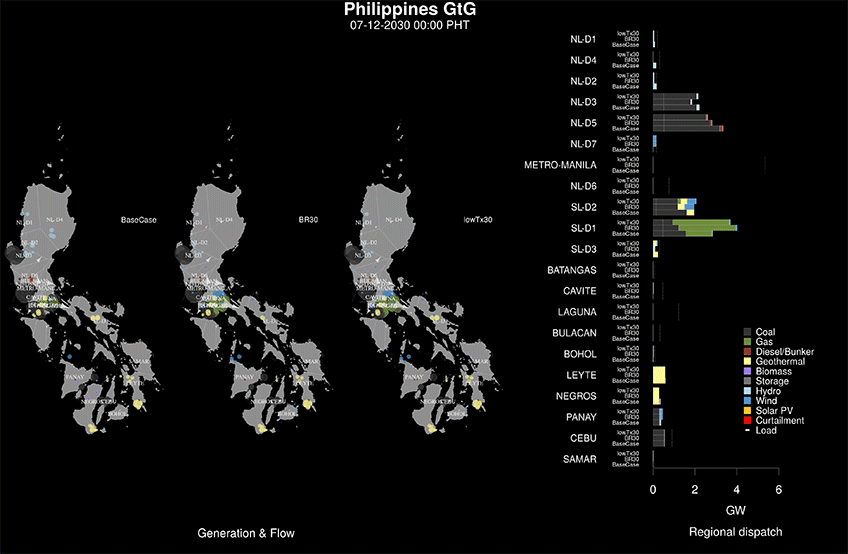How the Philippine Grid Could Achieve 30%--or Even 50%--Renewable Energy by 2030

Hourly animation of modeled results for the Base Case and two 30% renewable energy target scenarios for an example July day. Analysis by NREL.
Through a project sponsored by USAID and the Philippine Department of Energy (PDOE), the U.S. Department of Energy's National Renewable Energy Laboratory (NREL) recently released a report titled, Greening the Grid: Solar and Wind Integration Study for the Luzon-Visayas System of the Philippines. The study analyzes the Philippines's Luzon-Visayas power system and the implications of achieving different levels of renewable energy penetration by 2030. Produced by a modeling team with representatives from NREL, PDOE, the Grid Management Committee, the National Grid Corporation of the Philippines (NGCP), and the Philippine Electricity Market Association, "Greening the Grid" asks: if the Luzon-Visayas system had renewable energy penetrations of 30%—or 50%—by 2030, how would the power system operate?
According to the report, even the 50% goal is technically viable. In fact, the study didn't find a technical limit to renewable energy penetration even at these high levels. The modeled 2030 Luzon-Visayas system can balance—at all hours of the year—the high renewable energy scenarios that the study analyzed.
The study highlights five key findings:
- Renewable energy targets of 30% and 50% are achievable in the power system that's planned for 2030. Achieving these high renewable energy targets will likely involve changes to how the power system is operated.
- System flexibility will contribute to cost-effective integration of variable renewable energy.
- Achieving high levels of solar and wind integration will require coordinated planning of generation and transmission development.
- Strategic, economic curtailments of solar and wind energy can enhance system flexibility.
- Reserve provision may become an issue regardless of renewable energy penetration. Additional qualified reserve-providing facilities, including from solar and wind generators, and/or enhanced sharing of ancillary services between the Luzon and Visayas interconnections will likely be needed.
The grid integration study uses a production cost model called a security constrained unit commitment and dispatch model to understand the impacts of several renewable energy penetration scenarios. For each scenario, the production cost model simulated the scheduling of least-cost electric generation (based on variable—or production—costs) for every hour of the study year under representative weather, load, and outage conditions, while adhering to the physical constraints of the generation fleet and transmission network. The model provides quantitative insights about renewable energy curtailment (i.e., the reduction in the output of solar or wind generators from what they would otherwise be able to generate given available resources), thermal fleet flexibility, reserve provision, and transmission congestion at different annual penetration levels and siting strategies for solar and wind.
The study also assumes that additional generation and transmission capacity will be developed. Those assumptions are based on the official power sector development plans, which represent significant expansion beyond the infrastructure that exists today.
The results of the study are based on a collaborative and stakeholder-driven process. Over the course of the 18-month study, staff from the five agencies of the modeling team met bimonthly to review and analyze model inputs and outputs. In addition, a Technical Advisory Committee convened by PDOE and USAID and consisting of representatives from the public and private sectors met periodically to provide oversight and input to the modeling team on the most important questions and assumptions to address in the study. These stakeholder engagement efforts created ownership of the study among the Philippine organizations involved in power sector planning and operation and contributed to new human capacity to continue to plan for higher levels of variable renewable energy in the Philippines.
Learn more about the study by reading the full report.
Last Updated May 28, 2025
